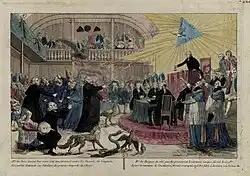
The French Revolution refers to a political revolution which began against the ancien régime of king, aristocracy and church in France in the summer of 1789 and continued for several years eventually leading to the execution of King Louis XVI and Queen Marie Antoinette and the establishment of the First French Republic. This was a hugely turbulent period of French history, one marked by bouts of extreme violence such as the Reign of Terror in 1793 and 1794 wherein tens of thousands of alleged opponents of the government came under suspicion of counter-revolutionary activity and lost their lives. As a consequence of all of this, there was a sustained flood of people out of France to seek refuge in neighboring countries or overseas. These were often the natural opponents of the new regime such as members of the old aristocracy and supporters of the monarchy, while Roman Catholics and Jews also left in large numbers feeling that they were no longer at liberty to worship in freedom in a France which was being established as a largely atheistic state by the revolutionaries.[1]
Chronology of eventsChronology of events

In the early modern period, France developed as one of the most autocratic or absolutist states in Europe. Many European countries were drifting during this period towards a form of absolutist monarchy in which the king claimed divine power and governed exclusively through himself, his ministers, and the powerful nobility and church. In some countries, though, this led to a violent reaction by the gentry and commoners in the hopes of retaining some of their rights. For instance, in Britain, the Wars of the Three Kingdoms were fought from the late 1630s onwards as people across England, Scotland, and Ireland fought to rein in the powers of King Charles I.[2] Eventually, such domestic clashes led in many countries to the beginnings of a democracy where parliaments achieved greater levels of control over the government of their nations. But in France in the seventeenth century, the process had gone the other way, particularly during the long reign of King Louis XIV, who established a highly absolutist monarchy which he ruled in an aloof manner from his palace of Versailles outside Paris. France became the paragon of absolutism in early modern Europe.[3]
Eventually, the system began to encounter problems. From the middle of the eighteenth century, France’s government experienced a series of crises, including harvest failures, losses in several wars with England and other nations, and an economic crisis. This was compounded by a broadly incompetent ruler in the shape of King Louis XVI. Things started to come to a climax in the 1780s, leading Louis to finally call a meeting of the Estates General at Versailles in the early summer of 1789. This was the French parliament. It had not met since 1614 and Louis intended only to convene it for long enough for the Estates to grant the government a large financial subsidy. However, within days matters began to slip out of the control of the king and government and the parliamentarians began organizing themselves to introduce wide-ranging reforms. The French Revolution had begun.[4]
The Revolution would last for several years. Early on famous events during it included the Storming of the Bastille Prison in Paris on the 14th of July 1789 and the subsequent forcible removal of the king and royal family from Versailles to Paris in the autumn. Henceforth the king and queen were effectively under a loose form of house arrest. The revolutionaries subsequently began taking over the huge estates of the nobility and Roman Catholic Church and reorganizing society to establish the universal rights of all men (their form of libertinism, unfortunately, did not extend to women) regardless of their ancestry.[5]
From 1792, as Austria, Britain, and other nations prepared to go to war with France to end what they perceived as a political abomination, the Revolution took on a harder edge and eventually the king and queen were placed on trial and executed. The French Republic was declared and over the next several years France experienced extensive turmoil as it was involved in wars on several fronts, encountered domestic revolts, and was subject to the Reign of Terror between 1793 and 1794 when extremist revolutionaries led by Maximilien Robespierre accused tens of thousands of French people of ‘un-revolutionary’ activities and had them executed by the notorious guillotine. The Revolution only finally came to an end in 1799 when Napoleon Bonaparte emerged as a successful general of the revolutionary armies and established a military dictatorship, eventually having himself proclaimed as Emperor of the French in 1804.[6]
Extent of migrationExtent of migration
Because of the divisive nature of the Revolution and the extreme waves of political action which characterized it, many tens of thousands of French men and women fled their country between 1789 and the end of the century. These typically were individuals who supported the old regime of king and nobility, individuals who feared for their lives if they remained in France and had already had their estates confiscated at home. Others, such as ardent Roman Catholics and Jews, also left France for fear that they would not be allowed to worship in freedom, particularly so once the privileges and liberties of the Roman Catholic Church were removed. Thousands of priests alone fled France during this era.[7]
Demographic impact of the French RevolutionDemographic impact of the French Revolution

The demographic impact of this was considerable. On the one hand, it removed a huge chunk of French society from the scene, most notably the parish priest which every community in France would have lived with for centuries. Huge numbers of these refused to take the oath of the Civil Constitution of the Clergy which would have required them to declare their allegiance to the state over the church and so left.[8] Many thousands of prominent Royalist supporters left France and headed to the capitals of foreign nations which were at war with France, notably London and Vienna. Many of these lived in these cities and formed exile communities there for decades, with some remaining on in their adopted nations even after the French Revolutionary and Napoleonic Wars came to an end in 1815. Finally, there was an exodus of many people to North America, many of them being Jews who were falsely suspected back in France of being in favor of a Counter-Revolution to overthrow the Revolution in the early 1790s. The parts of British Canada which had a strong French ethnic base and culture were particularly attractive sites for refugees from the Revolution and tens of thousands fled here.[9]
Explore more about the French RevolutionExplore more about the French Revolution
- French record collection on MyHeritage
- Ask The Expert – French Records at MyHeritage on the MyHeritage Knowledge Base
- An introduction to Filae: the largest source of French archives on the MyHeritage Knowledge Base
- Online Resources for French Genealogy part I: Compiled Records, Church Records and Civil Registration at Legacy Family Tree Webinars
- Online Resources for French Genealogy Part II: Military conscription, Census, Maps, Photographs at Legacy Family Tree Webinars
- Online Resources for French Genealogy part III: Succession tables, Electoral lists, Notarial Records, Newspapers at Legacy Family Tree Webinars
- Finding French Ancestors at Legacy Family Tree Webinars
- Introduction to French-Canadian Research at Legacy Family Tree Webinars
ReferencesReferences
- ↑ French Revolution. History Channel
- ↑ The Wars of the Three Kingdoms. History Today
- ↑ French history: ancien régime. Encyclopedia Britannica
- ↑ Whatmore, Richard. REVIEW ARTICLE: THE ORIGINS OF THE FRENCH REVOLUTION. History of Political Thought, Vol. 29, No. 4
- ↑ Some key moments in the French Revolution, 1789- 1794
- ↑ Napoleon's biography: 3. Consulate Napoléon & Empire
- ↑ French Revolution and Migration after 1789. EGO | European History Online
- ↑ Llewellyn, Jennifer; Thompson, Steve. THE ÉMIGRÉS. Alpha History
- ↑ Childs, Frances S. French Refugee Life in the United States, 1790–1800: An American Chapter of the French Revolution. Johns Hopkins Press, 1940.

